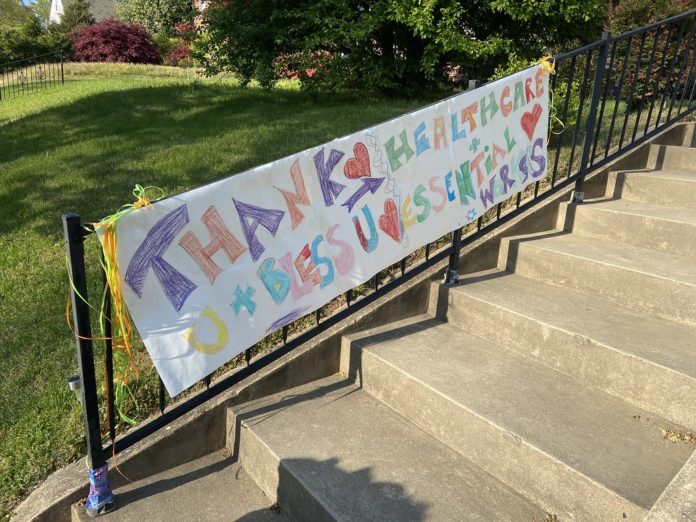This essay is a part of the COVID-19 dossier, edited by the b2o editorial staff.
By Muneeb Hafiz
In the UK, Black people across England and Wales are more than four times as likely to die from Covid-19 as white people; Bangladeshi and Pakistani people around three and a half times more likely; and those of Indian origin two and a half times as likely. Two thirds of British Bangladeshi men over the age of sixty have a long-term health condition that puts them at particular risk from infection, while underlying health conditions are also especially prevalent among older people of a Pakistani or Black Caribbean background. “Minority” groups are over-represented by as much as 27% in the overall Covid-19 death toll and 63% of the first 106 health and social care staff known to have died from the virus were Black or Asian. Around a third of all working-age people from Black African backgrounds, and over a fifth from Indian backgrounds are employed in “key worker” roles (Office for National Statistics, 2020; Siddique, 2020).
Body-Capital-Breath
Across the long night of capitalism, embodiment – skin, flesh, colour, labour – and the struggle to breathe have constituted its fundamental questions (Alcoff, 1999; Weheliye, 2014). Is it not true that in one way or another, in the end, everything brings us back to the body? That whatever our descriptive statement of the human (Wynter, 2003), whatever substance or hue is its form, the absorption of oxygen and release of carbon dioxide, the resuscitation of muscle and tissue, the creation of energy (to live and, more importantly, to work) through a series of dynamic exchanges, is what it all comes down to? Is life not at least in part an essential question of embodiment, and embodiment a question of what constitutes proper life? (Spillers, 2003).
And, thus, does its opposite, death, not become both an immanent question of how to dispose of the body that has ceased to breathe, and a transcendental question of what happens to the body in the time after it is no longer kept alive? Surely any assault on the body – saying nothing of the many wars on life which plague, and have constituted our modern moment – must have breath as both its affect and effect. Pain, grief, loss, anxiety, exhaustion, disease each having discernible if shifting consequences for one’s breathing.
What has capitalism – work and its faceless workers, labour and its mystification, multiplying services and its veiled supply chains – been founded upon if not the attempt to master the breath of countless hordes, to mobilise the metabolic and reproductive energies produced, and life sustained by their exhalation? (Hartman, 1997). Taking the long view, with the advent of the New World and the constitutive excrement of its discoveries – genocide, (trans)plantations, ecological catastrophe, disease, psychic, spiritual and familial alienation, human-wood, human-metal – to the appearance of the so-called “industrialised races” (of Europe) some several centuries later, the struggle to breathe of some, and the will to suffocate of others has been a world-founding dialectic (Wallerstein, 2011).
Capital’s Other
This back and forth between breath and its suffocation, between beings and those who would spit at them, between peoples simultaneously denied their humanity and put to work precisely on the basis of human creativity, has cleared the terrain, both physical and symbolic, for the assembly-line Products of “Liberty,” “Welfare” and the “Rights of Man” (Lowe, 2015). These gifts of progress are weighed down with the unanswered, unaccounted – though never completely invisible – subjects of the marked; the breath stifled, the beings told that they are not. For the conditions of their possibility (or, production) at home, among those who delegated to themselves sovereign will and the space to breathe, have required whole economies of silhouetted peoples denied their own, and industries of death elsewhere that have been modern Capital’s nuclear power plant.
There were always Others with whom nothing could be shared or owed, peoples turned into ghosts of an inaudible, imperceptible, delimited condition, despite the essential relation of dependence – or indebtedness – others have to them, and through whom their own lives are sustained. These people have been made to work for another who refuses to see her as such, who, in truth, could never allow cognition of the uneliminable fact of their shared embodiment. While both, ‘human’ (Man) and ‘labourer’ (ghost), require the space to exert energy and breathe, the spectre of the Other becomes also a vehicle for contamination who everywhere – in schools, in hospitals, in custody – challenges the sacred, but always already provincial, boundary of proper life due a share of the world, of the genre of the human constituted under regimes of capital. It is only he who is truly of here that becomes signatory to a contract of care and (re)cognition as an entity owed certain obligations. Those unfortunate Wretcheds over there, or indeed here, that is, the half-subjects of Capital’s bloody service supply chain, whose existence is registered as mere happenstance or as singular function, must instead be spoken for and kept clocking in (Fanon, 2001).
Despite the work they do and the forms they must fill, with bodies that move and hands that write and feel as well as work, these transients are the subjects par excellence of the application clause, or its internal logic of the exception: If you insist on being here then you must not be seen. If you insist on being seen then you must not be heard. If you insist on being heard then it must be in a tongue and with sentences of our choosing. And if you do indeed pick up this new language of ours then you would do well to forget your mother’s.
Dark mortalities
Our moment of mass death and the makeshift morgue, more corpses than we are willing to bring ourselves to count, drives home the inescapable limit of the body and breath. This despite the principle of unequal shares through which certain lives become disproportionately superfluous or at risk, and others naturally secured. To be sure, this virus has brought with it notions of a great levelling (Alexander, 2020). The reality that anyone, anywhere is vulnerable and, thus, its attack on our shared embodiment speaks to a planetary predicament in which each and every human is caught It is this reason that today death is measured as being in excess.
But just as the breathing or gasping body lives and labours in the midst of certain historical, social, political and economic tendencies, this levelling, which has brought on an hour of autophagy – bodies devouring themselves of the capacity to draw breath and live on – also shares in those tendencies. “Disease is never neutral,” Anne Boyer (2019) has told us, “treatment never not ideological. Mortality never without its politics.” This longstanding politics of mortality, which draws a great separation between the visible person and invisible worker, and has been instituted through industrial progress, its colony, outpost, and tax haven, is the systematic legislation of death and an all-out war on life. The freedom to live and breathe is made possible by many more who cannot.
It is not clear that this fundamental relation of my life to the death or murder of an Other has left us (Mbembe, 2003). Before the arrival of this virus, humanity – as both physical subject and ethical concept – was already threatened with suffocation (Mbembe, 2020). Entire segments of the earth’s population, entire races caught and mobilised in an intense struggle to breathe when others would have them disappear, or more fittingly under the reign of capitalism, die at work.
The sharing of tendencies between virus and the worldly context of its transmission, a world not so much of a great levelling but one built on a great separation (Fanon, 1967); of my body, breath and labour kept a world- and time-apart from the Other’s, thus speaks to and amidst certain regimes of erasure. Because of the industries of strangulation upon which the modern world was founded and continues to proceed, that the makeshift morgue has already been a central logic of capitalism, we were always already haunted by the supposed excess (death) of the Other long before this virus’s eruption.
This disproportionate risk, exposure and perishing to the virus is among peoples already marked, as Black, brown, poor, jobless, homeless, unsettled, resident with no recourse to public funds. That is, names which sanction the deaths of Others whose work sustains life elsewhere, a haunted exchange that should be set in the larger contexts of, and intimacies between, breathing, labouring bodies across time and space.
The relation of my life to the disproportionate death of an Other, a worker whose ‘key’ status is contingent on his/her ability to labour but whose humanness as worthy of protection has long been in question, speaks to a profound emergency that could never be recognised as such. This is a loss not merely of Black and brown life, of the marked person’s ability to breathe freely. It rather amounts to an exit from a confrontation with the scale of mass death, mapped yesterday onto faraway frontiers and processes of extraction, accumulation, settlement and repopulation, with all the skeletal and geologic spikes that were their castoff, and that today is right here, seeking answers.
A day after
The body of the Other has long been drawn as a vehicle for contamination, a haunting figure, who is there but not, who must be kept at bay, locked down but productive, one whose own suffocation or deportation allegedly spells safety for those unmarked. In this negative relation of my body to the breath of the Other, we have never learned how to die, never mind how to live, in a world that was always and remains the only one we have, and which we must share with everything that breathes.
The contingency of my breathing freely on the stifling of an Other (what is that if not at core a definition of freedom as it arose from colony), bespeaks the pathogenic quality of capitalism. The great levelling of this new virus that is transmitted and kills indiscriminately does its work in a world of deep discrimination. The profound unmooring of untimely death and grief drift through an earthly condition in which the premature death of its simultaneously marked (hypervisible) and neglected (masked) peoples is proposed as the natural order of things.
It is not a question, then, of pre- and post-COVID. There must be a more expansive notion of the day after. It must be one in which to have a body – at the level of species-being – is to be owed the space to breathe. The delimiting terms of the political sphere, of law and state, capital and its endless abstractions will no longer suffice if we are to learn how to live and die in-common, as occupants of ultimately transitory but visible life (Glissant, 1997). These are questions biospheric in nature and planetary in scale. We are from the very beginning “given over” (Butler, 2004) to the world of an Other – human and natural, this distinction can no longer be allowed to hold – however much their presence is denied. Each of us must now answer to our own names, and are to be held responsible for an Other’s share, for their right to breathe clean air, if this earth is to survive.
Now it is true that the day after may herald an even greater separation than before, that the relation of the body who lives and breathes to the many more who suffocate and die is deepened as a logic of our world, and given renewed legitimacy through euphemisms of economic recovery, (bio)political security and national integrity.
Living and dying together, breath and its expiration, however, is an, if not the unassailable surplus of being. Hard as some might try to graft the ephemeral and elementally vulnerable nature of our embodiment to the machine – the birth of the new synthetic-body or object-body or digital-body – living and dying together will remain our lot as beings on this earth-not-of-our-making. At least for now.
A proper day after will only come through today’s and yesterday’s reckoning, of both its light and dark faces, its breathing and gasping bodies. Until we bring ourselves to confront premature death’s relation to the manmade, though no less extrahuman, factors of race, gender, labour, wealth, citizenship and much more, our existence will be forever haunted by the lives and death of Others; our own bodies weighed down by the breathless who may well be gone but whose body-the-same-as-mine can never truly be denied.
Muneeb Hafiz is an Associate Lecturer in International Relations at Lancaster University, UK. His current research concerns the intersections between race, subjectivity and ecology.
Alcoff, Linda Martin. 1999. “Towards a phenomenology of racial embodiment.” Radical Philosophy, no. 95: 15-26.
Alexander, Ella. “Coronavirus is not a great leveller: we do not suffer the same.” Harper’s Bazaar, 12 April 2020. https://www.harpersbazaar.com/uk/culture/culture-news/a32107262/coronavirus-is-not-a-great-leveller/
Boyer, Anne. 2019. The Undying: Pain, vulnerability, mortality, medicine, art, time, dreams, data, exhaustion, cancer, and care. New York: Farrar, Straus and Giroux.
Butler, Judith. 2004. Precarious Life: The Powers of Mourning and Violence. London: Verso.
Fanon, Frantz. 1967. Black Skin, White Masks. New York: Grove Press.
Fanon, Frantz. 2001. The Wretched of the Earth. London: Penguin.
Glissant, Edouard. 1997. Poetics of relation. Ann Arbor: University of Michigan Press.
Hartman, Saidiya V. 1997. Scenes of Subjection: Terror, Slavery, and Self-Making in Nineteenth-Century America. Oxford: Oxford University Press.
Lowe, Lisa. 2015. The intimacies of four continents. Durham: Duke University Press.
Mbembe, Achille. 2003. “Necropolitics.” Public Culture 15, no. 1: 11-40.
Mbembe, Achille. 2020. “The universal Right to Breathe.” Critical Inquiry, 13 April 2020. https://critinq.wordpress.com/2020/04/13/the-universal-right-to-breathe/
Office for National Statistics, “Coronavirus (COVID-19) related deaths by ethnic group, England and Wales: 2 March 2020 to 10 April 2020.” ONS, 7 May 2020. https://www.ons.gov.uk/peoplepopulationandcommunity/birthsdeathsandmarriages/deaths/articles/coronavirusrelateddeathsbyethnicgroupenglandandwales/2march2020to10april2020.
Siddique, Haroon. 2020. “British BAME Covid-19 death rate ‘more than twice that of whites’” The Guardian, 1 May 2020. https://www.theguardian.com/world/2020/may/01/british-bame-covid-19-death-rate-more-than-twice-that-of-whites.
Spillers, Hortense. 2003. “Mama’s Baby, Papa’s Maybe: An American Grammar Book”, in Black, White, and in Color: Essays on American Literature and Culture, pp. 203–229. Chicago: University of Chicago Press.
Wallerstein, Immanuel. 2011. The Modern World System. 4 vols. London: University of California Press.
Weheliye, Alexander G. 2014. Habeas Viscus: Racializing Assemblages, Biopolitics, and Black Feminist Theories of the Human. Durham: Duke University Press.
Wynter, Sylvia. 2003. “Unsettling the Coloniality of Being/Power/Truth/Freedom: Towards the Human, after Man, Its Overrepresentation. An Argument.” New Centennial Review no. 33: 257-337.




